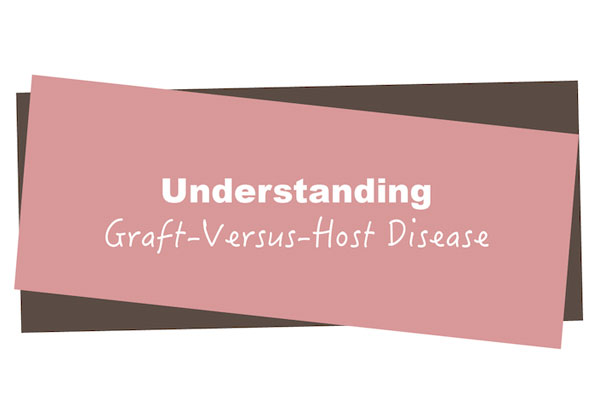Understanding Graft-Versus-Host Disease
Graft-versus-host disease is a serious complication that may occur after allogeneic stem cell transplantation. An allogeneic stem cell transplantation is a treatment for many genetic diseases, as well as blood cancers like leukemia and lymphoma. During allogeneic stem cell transplantation, a person receives stem cells from a donor or from donated umbilical cord blood. These “new” stem cells replace that person’s stem cells that have been damaged by disease or by treatments for the disease.
How allogeneic stem cell transplantation works
Before an allogeneic stem cell transplantation, the person undergoing the transplant receives a conditioning regimen consisting of chemotherapy and sometimes radiation therapy. The conditioning regimen is given to destroy cancer cells in the body (in people having transplants for cancer). The conditioning regimen also suppresses the recipient’s immune system, which allows the new stem cells from the donor to start making new blood cells and, ultimately, generate a new immune system in the recipient’s body.
When donor cells (the graft) attack the tissue and the cells of the recipient (the host), this condition is called graft-versus-host disease, or GVHD.
There is a lag between when the previous (the recipient’s) immune system stops functioning and the new (the donor’s) immune system takes over. During this period without healthy bone marrow, transplant recipients’ bodies are unable to make blood cells, including white blood cells. Without adequate white blood cells, transplant recipients are unable to fight infections properly, leading to a period of increased risk of infection.
After the conditioning regimen, transplant recipients receive an infusion of donor stem cells to replace their own blood-making system and immune system. The transplanted stem cells travel to the bone marrow where they begin to produce new white blood cells, red blood cells, and platelets in a process known as engraftment.
Donated stem cells that are transplanted also contain some T-cells from the donor. T-cells are a type of white blood cell that helps protect the body from infection. They recognize what belongs in the body and what is foreign and potentially dangerous. T-cells know that bacteria, viruses, and fungi are harmful. To defend itself from infection, the body must be able to distinguish between what belongs in the body (self) and what is foreign to it (non-self).
One of the benefits of an allogeneic transplant is that the donor T-cells may recognize as foreign any of the recipient’s cancer cells that survived the conditioning regimen. The donor T-cells are much more likely than the recipient’s own T-cells to identify the cancer cells as non-self, and they coordinate an attack to eliminate them. This helps prevent the cancer from relapsing. This is called the graft-versus-tumor effect.
But the same ability of T-cells to recognize self from non-self can create a severe complication. T-cells recognize self from non-self by a system of proteins, called human leukocyte antigen (HLA), that marks many cells. Human leukocyte-associated antigens are proteins found on the surface of most cells in the body. They make up a person’s unique tissue type.
To defend itself from infection, the body must be able to distinguish between what belongs in the body (self) and what is foreign to it (non-self).
The donor’s T-cells may regard HLA or other markers on the recipient’s cells as non-self and may attack the recipient’s healthy cells in organs, impairing their ability to function and potentially causing organ failure.
Graft-versus-host disease
When donor cells (the graft) attack the tissue and the cells of the recipient (the host), this condition is called graft-versus-host disease, or GVHD.
At first, the donor cells (the graft) are partially weakened and controlled by the transplant recipient’s own immune system. Graft-versus-tumor and graft-versus-host effects do not tend to reach full strength until the recipient’s immune system has been fully suppressed. This tends to happen early, within the first 30 days, with a myeloablative (full strength) transplant, but may occur later with a reduced intensity or a non-myeloablative (mini) transplant.
GVHD can be mild, moderate, or severe. Successful treatments for GVHD have been developed, but in some people, GVHD may not respond. In addition, treating GVHD often weakens T-cells and can leave transplant recipients more vulnerable to infections or other complications.
The development of moderate and severe GVHD is associated with significant illness and a decrease in survival. Once it is established, it is difficult to treat. Because of this, doctors try to reduce the occurrence and severity of GVHD before and after transplantation and take every precaution to prevent GVHD.
Excerpted with permission from The Leukemia & Lymphoma Society’s Graft-Versus-Host Disease fact sheet. For free information on blood cancers, contact The Leukemia & Lymphoma Society Information Specialists at (800) 955-4572 or visit LLS.org.
This article was published in Coping® with Cancer magazine, November/December 2022.


